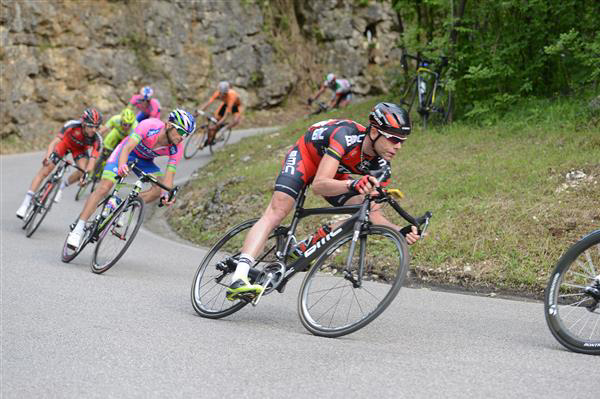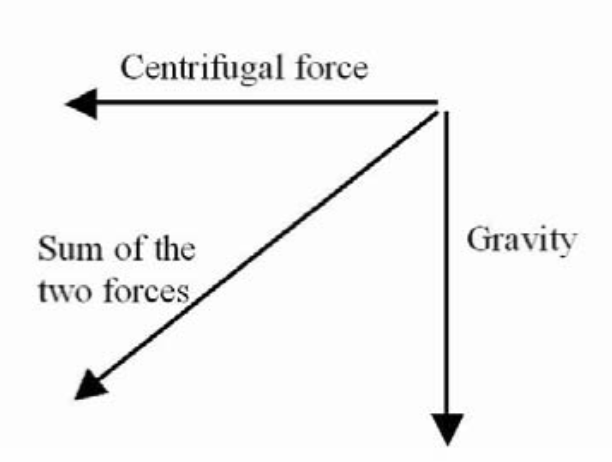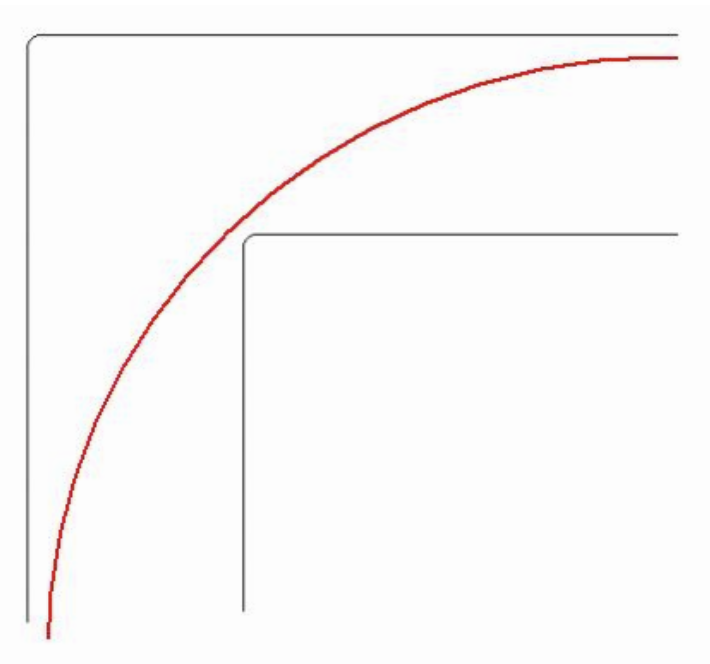Have a look at Aussie superstar and all-round nice guy, Cadel Evans, and take note of all the good cornering habits he can teach us.

Inside pedal up
The most basic and important thing to remember is to keep your inside pedal up, so that it does not clip the ground as you lean into the corner. Eventually you will become familiar with your bike so that you know how far you can lean before you have to stop pedalling, and how far back upright you must be before you can start again.
Lean the bike
Fast cornering is not about turning the handlebars, but more about leaning into the corner. Look at Cadel’s handlebars – they are just about straight. Don’t be shy about leaning your bike into the corner, road bikes and road tyres are designed for this.

The diagram on the right shows the major forces acting on you while turning. Pulling you downwards is gravity, which remains fairly constant. As you corner, centrifugal force will begin to pull you towards the outside of the corner. The faster you corner, the larger this pull will be. The diagonal line is the combination of the two forces. Your body and bike angle should match this line. You may need to push down with your outside foot to keep your body over this line.
Position your hands
In the picture, Cadel has his hands on the darops, which is the most controlled and fastest position, but it doesn’t matter if you feel more comfortable with your hands on the hoods (I do). The important thing is that you have control of the bike and are able to brake properly. Notice how Cadel’s fingers are resting at the ready on the brake levers, but he is not actually braking.
Brake before the corner
Try to do your braking as you approach the corner, rather than as you are going through it. Braking during a corner can increase the risk of losing traction and can upset the balance of forces, throwing you off your intended line.
Take a line
The fastest line through a corner is the straightest. Therefore, you should start wide, head towards the apex and then finish wide. If you look closely at Cadel, he is starting to head towards the apex. Timing your turn is also important. If you turn too soon you will hit the apex too straight and end up heading toward the outside gutter. However, be aware that there may be a difference between the racing line and the safe line through a corner. This will depend on whether you are riding on a closed road and where other riders are.

Look where you want to go
This will help your balance and direction. Notice how Cadel is looking intently at where he is about to exit the corner. You will find your bike pointing at whatever you are looking at, so don’t look too hard at that pothole…
Stay aware of others on the road
As you approach a corner scan the road and the exit to make sure there is nothing that will upset the friction of your tyres, such as glass, gravel or water. Adjust you line and speed accordingly.
Also know where the bikes surrounding you are – is there someone riding to your left or right?
Watch out for people braking late and trying to overtake you on the inside as you start to turn into the corner. This is a really bad habit as they will end up crossing your line and you will have to take evasive action. Don’t do it yourself but be aware that people inevitably will.
Remember, when bunch riding we should try to avoid overlapping our front wheel with the wheel of the bike in front of us. This is particularly important coming into a corner, as people will start moving sideways.
Practice
Like anything else, the best way to get better is to practice. If you can find a safe corner to practice on, work on your line and timing your turn at various speeds. Look through the corner at the exit. Practice going around with just one hand (try putting the other one behind your back) to develop your handling skills. Get your body leaning at the correct angle to counteract the sum of the lateral and downwards forces.
Have fun and stay safe.
References
Adapted from previous club material
Perfect Conditions Multisport Coaching Consultants. Perfect Condition Ltd (retrieved on 30 January 2022)
Last updated: 30 January 2022